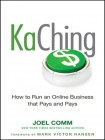KaChing: How to Run an Online Business that Pays and Pays Comm, Joel (books for 8th graders txt) 📖

Book online «KaChing: How to Run an Online Business that Pays and Pays Comm, Joel (books for 8th graders txt) 📖». Author Comm, Joel
TELESCOPE REVIEWS
Telescope Reviews (www.telescopereviews.org.uk) is exactly what you might expect of a site optimized to make money from affiliate products. Based in the United Kingdom, the site offers “unbiased reviews” of a wide range of telescope brands. But you have to look for those reviews. Surf to the home page, and the first thing you’ll see is three navigation tabs leading to “home,” “cheap telescopes,” and “cheap binoculars.” To find links leading to reviews of different brands or models, readers have to scroll past the ads. This is a site in which selling, and leading people to buy, comes before the content.
Beneath those tabs is a long list of Amazon affiliate links. To the right, an Amazon widget allows the site another opportunity to earn from an affiliate sale. You have to scroll about half a dozen screens before you see the end of the affiliate list and reach the first review.
What the site calls “unbiased” actually means impersonal. There are no accounts of the writer using the telescope, what he or she finds interesting about it, or why it marks a development in home-based astronomy or the science of peeking at neighbors. Instead, readers receive a long, detailed list of features ... followed by a box filled with affiliate links.
There are a lot of sites like this on the Web. Publishers know that buyers research major purchases online before parting with their cash, so creating a review site looks like an easy way to earn a commission on those sales. But while it’s possible to make some money surrounding related words with affiliate ads, to make real money—the kind of money that makes the whole thing worthwhile—the content still has to be good.
The content on Telescope Reviews isn’t good. It looks like it was thrown together by a five-buck-an-article content writer in Ban-galore. It’s unlikely that anyone seriously interested in buying a telescope is going to hang around long enough to decide to buy, and they certainly won’t come back. Whatever the publisher is saving on writing expenses will go to pay for search engine optimization and traffic generation to keep people flowing through.
It’s much easier to produce good content about products related to a topic that interests you. Use that content to create a community, build trust, and bring readers back, and you’re much more likely to see them clicking through your affiliate links and sending you money.
DIGSDIGS
If Telescope Reviews is a good example of how not to create an affiliate site, DigsDigs (www.digsdigs.com) is an excellent example of the right way to make the most of the opportunities provided by affiliates (Figure 8.5).
The site offers information about home decorating and interior design, a field rich in potential affiliate sales. But it doesn’t rely on affiliate sales and it doesn’t shove affiliate links forward at the expense of good content. Instead, the site offers the kind of content that creates desire and provides a way for readers to satisfy that desire by making a purchase.
That also means making the most of other revenue streams. Telescope Reviews places an AdSense half banner above each article, but the units are not well optimized and are easily ignored. DigsDigs uses a horizontal link unit directly beneath the navigation bar and has changed the color of the links to match the color of the site’s own links and headlines: an attractive purple (Figure 8.6). That’s smart blending. The ads now look like content. There’s an image ad on the right, and more square units can be found above each article and sometimes between the images contained within articles, a placement that’s close to impossible to miss.
Figure 8.5DigsDigs writes about products, but offers much more than reviews, recommendations, and affiliate links.
The result is lots of ads about a range of different household topics, but they aren’t obtrusive and they don’t feel like they’re being pushed on the reader. That’s certainly true of the affiliate links. These don’t appear in every article, even when the post is discussing a product.
That makes for some smart choices. DigsDigs talks about products as wide-ranging as designer bathtubs and elite coffeemakers. Many of those products are going to be interesting but produce few sales. Others are fun and practical and cheap enough to be an impulse buy. If it’s commercial enough to be on Amazon, there’s a chance that a reader will be interested enough to snap it up. That’s when DigsDigs tends to include affiliate links.
Figure 8.6DigsDigs is a great example of the right way to do an affiliate site.
The site produces content that’s interesting and attractive. It’s designed in a way that makes it a pleasant read, with pictures that allow for quick browsing and fun viewing. It also has a Twitter timeline that enables it to build the base of a community, members of which are likely to click through the links and make money for the publisher.
DigsDigs isn’t obviously a product site. But when it discusses products, it’s already built up enough trust and interest to have a good chance of turning those mentions into affiliate sales.
Information Products
Information products come in a range of different forms and play a range of different roles in the Internet businesses of entrepreneurs. For some publishers, they might provide nothing more than a little supplementary income, an extra revenue source on a site that makes most of its KaChing from advertising. For others, they’re the main deal. The web site helps to promote those products and build a brand.
BRAD CALLEN
Brad Callen might not be long out of his twenties, but there’s little he doesn’t know about Internet marketing. He has his own software company, Bryxen Software, and he’s produced a series of information products about a variety of different aspects of online marketing. If you visit





Comments (0)